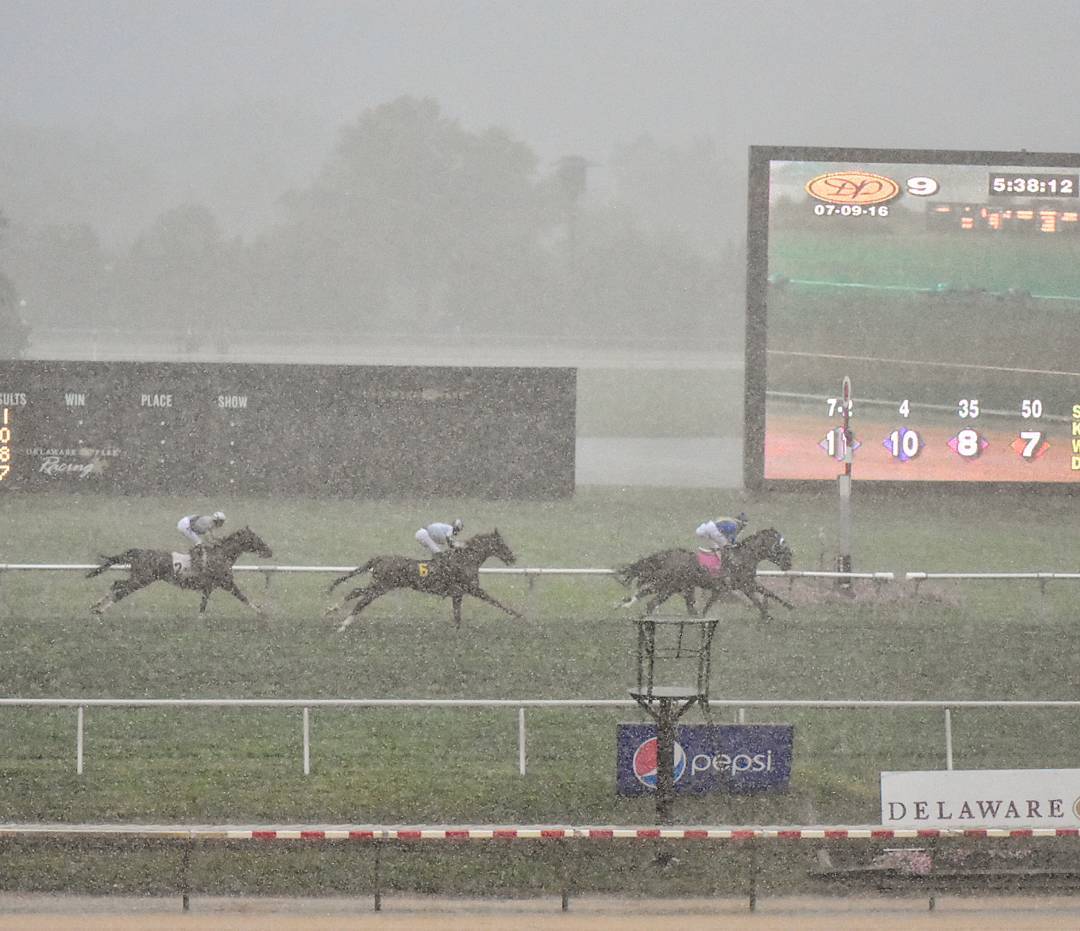
Track management constantly assess surfaces during the day. Conditions can change at any time, especially when a torrential downpour happens during a race. Photo by Steve Heath
Whether a horse is galloping toward the wire or heading to a new career, the ground beneath their hooves can shape everything from performance to injury risk. For off-track Thoroughbred (OTTB) owners, understanding how racetrack surfaces work — and how conditions change throughout a race day — can offer valuable insight into a horse’s past and help guide future training decisions.
In this article we’ll explain how track officials evaluate dirt and turf conditions, what those conditions mean and how they affect horses on race day and beyond.
Types of Track Conditions: Dirt Tracks
A racetrack’s maintenance team assesses and updates the track’s status frequently throughout the day. Each evaluation helps inform them of what changes need to be made to the track to ensure horse safety.
“We usually decide about 11 a.m. what we’re going to call the track for the day, then continuously monitor it,” says Jim Pendergest, director of racing surfaces at Keeneland, in Lexington, Kentucky. “For dirt tracks, the rating can shift during the day depending on the weather or as the track dries out and is worked by tractors. On race day especially, we’re constantly assessing the track.”
Even though most dirt tracks are composed of similar materials, variations between tracks — due to location — can still affect the likelihood of certain track conditions.
“Every dirt track has a slightly different mix of materials,” says Elizabeth Rogers of the University of Arizona’s Racetrack Industry Program, in Tucson. “For example, one track’s fast surface might be sandier and slower, while another with more clay might produce faster times.
“The track was sand-based at Mahoning’s (Mahoning Valley Race Course, in Youngstown, Ohio) track, which was great for winter racing because rain and snow drained more effectively,” she continues. “At Thistledown (in North Randall, Ohio), which runs in the summer, the track has more clay, helping it retain moisture under the hot sun. If you don’t put enough water on a sandy track, it’s like walking on dry beach sand — very hard to move through.”
Common dirt track conditions include:
- Fast (FT)
- Frozen (FZ)
- Good (GD)
- Heavy (HY)
- Muddy (MY)
- Sloppy (SY)
- Slow (SL)
- Wet Fast (WF)
The optimal condition for dirt tracks is “fast.”
“With a ‘fast’ track condition, there’s usually some moisture in it to help with cushion,” Rogers says. “This gives the horse a solid surface to push off of while still providing shock absorption. That’s why it’s one of the safest and fastest conditions.”
However, moisture must be carefully monitored and maintained even on a fast track. “Tools like a TDR (time domain reflectometry) are used to measure it, with a target of about 18% moisture at tracks like Keeneland,” says Pendergest.
If rain falls during the day, a dirt track might be called “wet fast,” which still allows for fast racing despite standing water. “As the track becomes wetter and water seeps into the base, it transitions to ‘sloppy,’” says Pendergest. “When there is less water, the track is termed ‘muddy,’ with a sticky surface resulting in slower performance.”
Racetrack management uses the terms “good” or “wet fast” for tracks to describe certain track conditions falling between others. “Some tracks use the term ‘good’ to describe when a track is drying out but hasn’t reached fast status,” says Rogers. “Others call that ‘wet fast’ — they’re essentially the same thing.”
A muddy racetrack also taxes horses more. “It’s more tiring for the horses that race over muddy versus a fast track,” she says. “While some horses love a muddy racetrack, others don’t.”
This often results in trainers scratching horses that struggle on or dislike muddy footing or have prior injuries. Trainers typically aren’t penalized for scratching a horse due to valid medical concerns. “Especially horses with old bowed-tendon injuries, they’re usually scratched if the track has too much water,” Rogers adds.
However, there’s a point where the amount of water reverts the track’s condition.
“When there’s tons of water in that racetrack, you get what we call a sloppy racetrack,” Rogers says. “Surprisingly, sloppy tracks can result in faster race times. A sloppy racetrack reverts to being more like a fast track in terms of times and speed. This happens because the material splashes away when the horse’s foot falls onto the track surface. They drop further into the dirt and hit what we call the base of the racetrack.”
Prominent racetracks often have the advantage of more manpower and chemical resources to manage challenging track conditions. However, even then, track closures can still happen — to prioritize safety for both horses and riders.
Managers of private training tracks must also meticulously monitor their surfaces, especially those in colder regions, when potential exists for the track to freeze. This is called a “frozen” track condition.
Jorge Duarte Jr., a racehorse trainer from New Jersey, explains, “Winter track maintenance is challenging, especially with constant temperature swings. In January we closely monitor moisture levels and use the right additives. If there’s too much moisture, the track can freeze, so we especially check low spots and shaded areas. If the track’s frozen in the morning, we might delay training or jog the horses slowly to allow it to thaw.”
Types of Track Conditions: Turf Tracks
Some turf track conditions share names or characteristics with those on dirt, but turf surfaces come with their own set of common conditions, such as:
- Firm (FM)
- Good (GD)
- Hard (HD)
- Soft (SF)
- Yielding (YL)
The industry considers the optimal condition for turf tracks as “firm,” like “fast” on dirt tracks.
“Firm refers to a track with the ideal moisture level — soft enough to give slightly underfoot, but not soggy,” Rogers says. “It’s similar to walking on grass after a rainstorm the day before, where the surface provides some give but not excessive sinking.”
A “hard” turf course — typically seen during droughts — carries less moisture than a “firm” track. “It lacks the give of an ideal surface,” Rogers says. “While most tracks water their courses to avoid this, a hard track offers less cushion and shock absorption, which can be unsafe for horses.”
A “good” turf track condition indicates softer ground still manageable for horses. In contrast, a “soft” condition means the ground is even more yielding, allowing footprints to remain after a horse passes.
“Soft is a little more tiring, and horses may struggle to push off as easily, leading to slower speed times,” Rogers explains. “Soft conditions are rare in the U.S., as they are more common in Europe due to higher rainfall. In the U.S., when turf conditions become too soft, races are often moved off the grass to protect the course.”
“In rare cases, such as after a downpour, the track can also be labeled ‘soft,’” Pendergest says. “However, if it progresses and becomes too soft, it is labeled ‘yielding.’” Horses running on a yielding turf surface can cause significant damage.
Maintenance crews use tools such as vibrating rollers and fill holes with sand when turf courses sustain damage. “They’ll try to patch up the holes and pack the turf down to encourage root growth,” Rogers explains. “Maintaining healthy grass roots is crucial for withstanding the strain of horses continually racing over them.”
Track Condition Preferences for Racehorses
Track superintendents and their maintenance teams aim to prioritize horse safety. But the track conditions that suit most horses might not be ideal for others. Each horse has its preferred track conditions, which can significantly influence how he runs in any given race.
“Some horses are built to handle less-than-ideal surfaces better, due to their conformation, athleticism or personal preference,” Rogers says. “It also comes down to training. Horses trained on muddier surfaces are better equipped to handle them, as they’ve developed different muscle groups to cope with the less-than-ideal footing. Training over conditions like what they’ll face in competition helps the horse build muscle memory.”
It can be hard to predict which surfaces horses prefer. “Breeding can play a role — some horses are bred for grass, others for dirt — but it’s not always clear cut,” says Pendergest. “The only real way to know is to test them on different surfaces and see which one they prefer. For example, Secretariat was exceptional on any surface, winning the Triple Crown and (also) excelling on turf. Some horses take to it while others don’t, so it comes down to trial and observation.”
“I’ve seen horses with no pedigree for the turf, and they handled it well,” Duarte says. “It’s mind-blowing, but that’s how they develop sometimes.”
The risk of injuries also varies between horses and surfaces. Horses often face increased likelihood of injuries when moving to a new racetrack. “Their bodies aren’t fully adapted to the new track’s configuration, leading them to push themselves too hard, which increases the risk of injury,” Rogers says.
Different track surface types are also associated with different injury profiles. “Synthetic and turf courses tend to cause more soft-tissue injuries, like those to muscles, tendons and ligaments,” Rogers says. “Dirt tracks, however, tend to cause more hard-tissue injuries, such as bone fractures. Synthetic tracks, being stickier, prevent the natural sliding motion of a horse’s foot, which can also contribute to injuries. The debate continues over which surface is safest and how to improve track conditions to reduce risks.”
What Horses’ Track Condition Preferences Mean for Retraining OTTBs
While horses can certainly adjust with training and further exposure to riding over different surfaces in their next career, each horse still has his own preferences regarding ground conditions. However, the way horses handle certain track conditions might be an indicator of their next career.
“Think about cross-country, where the weather is perfect some days — the horses just breeze through the course,” says Rogers. “But other days, it’s wet and miserable, and horses struggle at the jumps, slipping as they try to clear them. It’s like what you see on the track — some horses handle those wet conditions just fine and push through, while others, after one slip, lose their confidence completely.”
“If you’re looking for a jumper, and the horse doesn’t handle a firm turf course or a hard dirt surface well at the track, it may not be well-suited for jumping,” Pendergast says.
For your horse’s safety and longevity, Duarte says it’s essential to think about your arena the same way racetracks manage their surfaces.
“If your arena doesn’t look good that day, keep the workout light and use common sense — it really goes a long way,” Duarte says. “It never hurts to walk around the arena and check things out — sometimes you’ll catch something you didn’t expect that could put your horse at risk. It’s worth taking the extra time, especially if your horse is recovering from an injury or has an old injury; you may as well play it safe.”
Take-Home Message
Understanding racetrack surface conditions can help OTTB owners make informed decisions about training, injury prevention, and career paths after racing.

